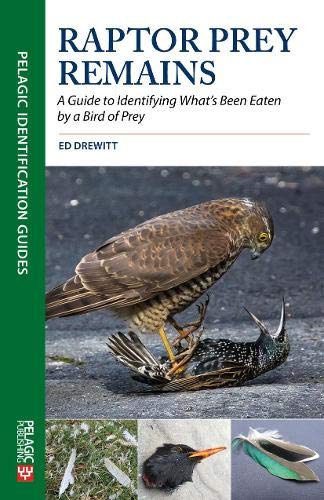
This is the type of book you will like if you like this type of book, or probably more likely, if you need this type of book. It is clearly a niche publication of most use to raptor workers who often visit the nests of raptors and want to identify the prey remains that they find. For that reason, you are unlikely to find it on many airport book stands (remember airports?).
However, while I do not fit into that category of reader I found the book facinating. Ed Drewitt has been poking around in raptor nests for many years, see his excellent book on Urban Peregrines (reviewed here) which is based on 20+ years’ research, but he started collecting skulls and feathers as a boy.
The bulk of the book consists of images of bits of over 100 species, mostly birds, that you might find in raptor nests or on plucking posts etc. These concentrate on those parts of the bird you are most likely to encounter under such circumstances and which are of most help in clinching identification. They are fascinating – truly fascinating.
There are a few minor gripes with the book. Lots of raptors eat mammals rather than birds but the emphasis here is strongly on birds so it fills a gap in the literature but you have to go elsewhere for the mammal information. Also, the pagination usually means that each prey species has a page to itself or a double page spread but now and again (I guess because the prey species are in taxonomic order) a species occupies two pages but starts on a right hand page and spills over onto the left hand of the next spread – where it is juxtaposed with another species on the right hand page. This did catch me out thinking, on pages 184-85, ‘I know I’m rubbish at this, but that doesn’t look like a juvenile Robin to me’ for a few seconds (Mistle Thrush actually).
There are hundreds, but probably not thousands, of people who will want this book and we should all thank both the author and publisher for providing this reference book based on the expertise of the author. It comes close to being a public service as it encapsulates the author’s knowledge, masses of work has gone into it and nobody will make even a small fortune out of it (I predict).
If you do take it on a plane journey, or a rail trip, then you are likely to find your neighbour peeking at the pages of your book and looking puzzled. Also, it there were a betting market on the winner of the Diagram Prize then this title would be an outside chance, I reckon.
Raptor Prey remains: a guide to identifying what’s been eaten by a bird of prey by Ed Drewitt is published by Pelagic.
[registration_form]